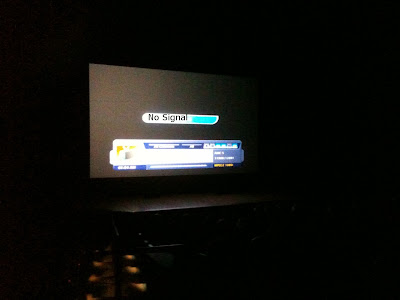It must have been utterly thrilling at the opera-house, to see this all come together (opera can pull it off, despite the celebrated last-minute disappointment of the final effect to work at the premiere--but I'd rather the set stopped than 90,000 pounds of metal crush a Rhinemaiden...). At the theatre, where we sat in rapt anticipation for the opening E-flats, the picture went even flatter:
But no matter; it was the old problem of the sun outshining the satellite signal, and it passed momentarily. The only speeches from the stage were about being sure to hit the head before it all began as there were No intermissions. Of course, going to see a 2-1/2 hour film wouldn't bother anyone, and by all rights, that was what we were going to see.
Terrific singing; terrific production, so ultra high-tech that it was nearly a parallel experience: hearing the opera, watching the set. Like a demonic keyboard it twiddled its keys and shifted its planes, sometimes in concert, sometimes a few boards at a time. Using the sorcery of lighting effects and video effects it became its own creature, far more fearsome than anything Wagner ever cooked up. Everyone singing this difficult music also had to contend with being hooked to a cable and having to defy gravity. The challenge of this production was to set it all right on the hairy edge of ludicrousness. Either you buy it or you don't (yes, I know: all theater is--or should be--that way). Singers arrive tobogganing down the set on sleds that seem to be on fire, glowing beneath them like neon chafing dishes. Loge has a pulsating flame beneath him as he walks, and his fingers light up like some loopy PowerRanger. Fricka has a pulsing, glowing brooch like E.T.'s heart, or the Golem's power-pack. And most amusingly, Alberich turns into a Harry-Potterlike skeletal dragon, then a Warner Bros. cartoon toad. Who says Wagner was too serious? After all, Alberich to me always looked like this:
--and somehow, when you see him in dreadlocks and a Naugahyde lace-up bag he looks more like one of those punch-'em down clowns that always bounce back up (which rather sounds like Alberich). I always think concretizing operatic characters is dangerous.
But Wagner is doubly dangerous, since this particular work has gripped the fascination of the musical world, and everyone and his Uncle Regie thinks they can make it a better experience than another. Elsewhere I have given my opinion as to what these operas are trying to say, and I am always astounded at the perfection of the orchestration and the beauty of the individual scenes, musically. But the question of pacing, of courting the audience's attention, of introduction and summing up are so scrambled and--how you say in English--looseygoosey--that it gets in the way of my total enjoyment of The Ring, and makes Anna Russell's digest of it all the more attractive. It would never fly in Hollywood. You see, this is a great lesson, auditors, this is what happens when you have a writer-composer-director-conductor who is given "free rein" to create, with no boundaries, no editors, no out-of-town tryouts. I am an active proponent of the One-Evening Ring (see: Sigurd), or maybe a nice two-evening Ring. But we are stuck with what Wagner gave us, and with all his faults it's he they adore. Rather like Wotan and his peek-a-boo locks.


No comments:
Post a Comment